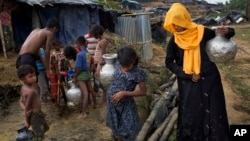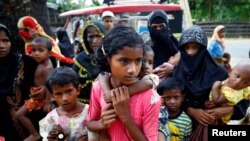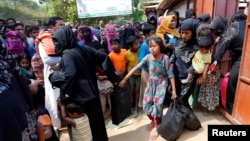Bangladesh is pressing ahead with plans to combine two settlements for Rohingya refugees from Myanmar into one large camp that those inside will not be allowed to leave, according to a senior government official who emphasized the new facility would be temporary.
Upwards of 800,000 Rohingya Muslims are now in southern Bangladesh. More than half of them fled from Myanmar's northern Rakhine State in the last few weeks after insurgents from the Arakan Rohingya Salvation Army attacked security forces on August 25, prompting a brutal crackdown that senior United Nations officials have called "a textbook example of ethnic cleansing."
Mohammed Abul Kalam, Bangladesh’s refugee relief and repatriation commissioner, told VOA this week the government’s main focus is to bring Rohingya refugees who are scattered across two districts near the Myanmar border to a demarcated allotment of more than a thousand hectares of land in Ukhia sub-district, effectively merging the longstanding Kutupalang and Balukhali camps.
“Currently, we are constructing a connecting road, culverts and alleyways, mainly to make the place accessible for our temporary facilities. Both the army and the local engineering department are involved with the construction work,” he said. “We plan to set up all necessary facilities, including mosques, latrines, bathing places and water facilities. But we will build all those on a temporary basis.”
Bangladesh insists Myanmar take back all Rohingya who have poured over the border. More than 500,000 have come since the August 25 attacks. But Kalam said the government is not calling the new arrivals "refugees." Nevertheless, he said they will need to be registered.
Myanmar has said it will take back those who have fled recently, but under a citizenship verification program that leaves Rohingya with little hope of returning.
After the road aspect of the mega camp is completed, there will be police outposts and also barracks for Ansar, an auxiliary force that will assist authorities with protecting the camps, according to Kalam.
The movement of people living inside will be severely restricted after the project is finished.
“We will not allow them to come out of the camps once it is completed. We will not allow them to be mixed up with the locals and they will have to remain in the camps where we will arrange all facilities they might require for their livelihood,” Kalam said.
He said the government had two central priorities regarding the Rohingya crisis.
“First we want to provide them with necessary assistance, including medicine, food and shelter. Secondly, we want about one million displaced Myanmar persons [in Bangladesh] to be repatriated to their country under a durable and acceptable mechanism,” he said. “For a durable and acceptable solution and their sustainable repatriation, we need cooperation from the world as we have [few] resources and land to share with them. Remember, we are poor with a large population.”
The effort to create what will become one of the world's largest refugee camps has been met with a mix of caution and consternation.
Vivian Tan, a spokesperson for the United Nations High Commissioner for Refugees, or UNHCR, said the agency appreciates the “tremendous challenges” faced by Bangladesh in managing the arrival of half a million people in such a short time.
“It's understandable that some temporary measures may need to be taken at the start of an influx for local authorities to manage new arrivals, including identifying specific locations for people to stay or imposing some limitations in movement,” she told VOA. “UNHCR hopes that any measures taken that restrict the freedoms of refugees are temporary and time-limited, and only for the purposes of screening and identifying those on the territory.”
She said registration can be an effective alternative to placing limits on movement, adding that the government has started biometric registration and that UNHCR is helping conduct family counting.
Matthew Smith, the co-founder of Fortify Rights, which has investigated abuses against the Rohingya in Myanmar, said the mega camp is a “terrible and dangerous idea.”
“It's impractical to attempt to enclose that many people within a single camp, and it would create even more problems in the delivery of aid, which will already be challenging,” he said. “There needs to be at least a couple dozen new camps. The authorities need to recognize that refugees have rights, and that includes the right to freedom of movement. Creating an enormous internment camp is not the answer.”
Many are skeptical about the willingness of Myanmar to allow Rohingya to rebuild their lives in northern Rakhine State.
In a speech on Thursday, the head of the civilian government, State Counselor Aung San Suu Kyi, said resettlement and repatriation are among the government's three main tasks in response to the crisis.
But in comments released earlier that day on Facebook, army chief Min Aung Hlaing said the Rohingya, whom he referred to as Bengalis, were not native to Myanmar and that the numbers reported by the media about the refugees were exaggerated.


















